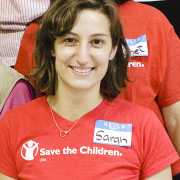I recently traveled to East Tennessee, up in the Appalachians, and the green and mountainous beauty all around really struck me. At the same time, I heard how difficult life there can be, especially for the adorable elementary-school children I was meeting. My local colleagues shared with me a wide variety of risk factors these children face. Chronic poverty, domestic violence, neglect. Hunger, substance abuse, absent, deceased or incarcerated parents.
Across the high-poverty, low-resource U.S. communities where Save the Children works, these childhood experiences are regrettably common. So are the risks that early traumas will have a lifetime of impact on children.
Research shows that trauma can have a significant impact on classroom learning. In infants and very young children, trauma changes brain chemistry and affects how the brain develops. Children may not even remember the trauma, but it has forever altered the trajectory of their healthy development. Preschoolers and elementary students may regress from important developmental milestones, while older children may engage in risky behaviors. Children of all ages may struggle to concentrate or act out. The correlation between impoverished communities, childhood trauma, and low academic achievement is no coincidence.
There is also good news about what research shows. We know that school-based social-emotional learning programs can help mitigate early trauma and improve academic performance. Children with increased resilience and coping abilities not only do better emotionally, they do better in school.
With that in mind, we have started layering our social-emotional program Journey of Hope into our existing literacy programs in schools. I was very happy to hear of the impact it is having in Tennessee. Children are not acting out as much, they’re concentrating better. They’re doing better in their classes, and they’re carrying the coping skills they’ve learned beyond the end of the Journey of Hope program. Now, for instance, a child will go to a trusted teacher and say they need to talk when something is bothering them.
Journey of Hope was created in partnership with children we served after Hurricane Katrina devastated their Gulf Coast communities. We learned from them that there was much more going on in their young lives than was directly linked to Katrina. Other traumatic experience kept coming at them. At home and also at school. On the children’s advice we added bullying to our eight-session program, which also gives kids of all ages the chance to creatively explore and discuss safety, fear, anxiety, sadness, anger and aggression and self-esteem.
Having this kind of programming can make a world of difference to a child and their future. Academic evaluations of Journey of Hope find that children show improved coping skills, greater faith in themselves, fewer disciplinary referrals and improved relationships with their peers. To date, the program has reached over 85,000 children in ten U.S. states and five other countries.
What’s become very clear to us as we’ve expanded Journey of Hope beyond post-disaster settings is that children facing all sorts of challenges across many different settings can benefit immensely from greater social-emotional supports. As greater understanding of the benefits of these types of programs spreads, we are hopeful that access to them will as well. That will be a very good thing for children everywhere.



The views and opinions expressed in this post are those of the author(s) and do not necessarily reflect those of MomsRising.org.
MomsRising.org strongly encourages our readers to post comments in response to blog posts. We value diversity of opinions and perspectives. Our goals for this space are to be educational, thought-provoking, and respectful. So we actively moderate comments and we reserve the right to edit or remove comments that undermine these goals. Thanks!